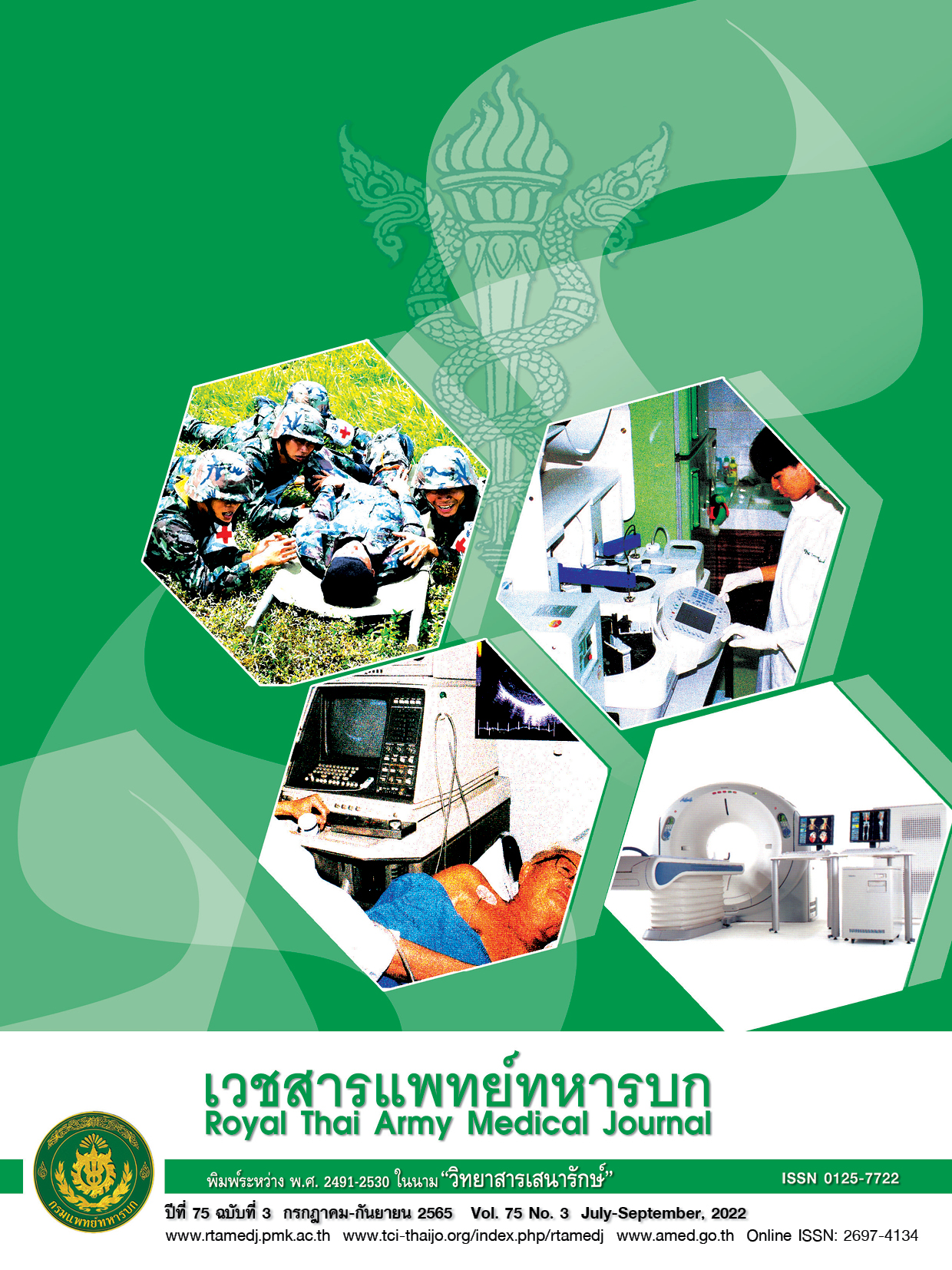การแพร่ระบาดของโรคโควิด 19 กับการเพิ่มขึ้นของภาวะสายตาสั้นในเด็ก
Main Article Content
บทคัดย่อ
ภาวะสายตาสั้น คือ ความผิดปกติของค่าสายตาชนิดหนึ่งที่แสงที่ตกกระทบจากวัตถุไปโฟกัสตรงส่วนหน้าของจอประสาทตาเมื่อเกิดการหักเหของแสง ส่งผลให้การมองเห็นภาพไม่ชัด นอกจากจะส่งผลต่อคุณภาพภาพชีวิต การเรียน หรือบุคลิกภาพของผู้ป่วยแล้ว ยังอาจส่งผลตามมาถึงสุขภาพของดวงตา ความผิดปกติของดวงตาซึ่งสัมพันธ์กับภาวะสายตาสั้น ซึ่งอาจจะทำให้การมองเห็นลดลงหรือ สูญเสียการมองเห็น เช่น ภาวะวุ้นตาเสื่อม รอยฉีกขาดที่จอประสาทตา จอประสาทตาหลุดลอก จอประสาทตาเสื่อมโดยเฉพาะที่จุดรับภาพ ต้อกระจก และ ต้อหินมุมเปิด ทั้งนี้ภาวะสายตาสั้น ปัจจุบันพบอุบัติการณ์มากขึ้นทั่วโลกและกำลังเป็นปัญหาทางเศรษฐกิจและสังคมที่น่ากังวล โดยเฉพาะในทวีปเอเชีย พบมีอุบัติการณ์สูงกว่าในฝั่งยุโรปและอเมริกา ปัจจัยที่ทำเกิดภาวะสายตาสั้น มีหลายองค์ประกอบ ตั้งแต่ปัจจัยด้านพันธุกรรม รวมถึง สาเหตุอื่นๆเช่นการเพ่งระยะใกล้ และการลดลงของการออกกลางแจ้ง นับตั้งแต่มีการระบาดของโรคโควิด 19 ทำให้มีชีวิตวิถีใหม่เกิดขึ้น เช่น การเรียนออนไลน์ การทำงานผ่านจออิเล็กทรอนิกส์ที่บ้าน และการใช้ชีวิตนอกบ้านลดลง ซึ่งล้วนเป็นความเสี่ยง ซึ่งอาจส่งผลกระทบทำให้เกิดอุบัติการณ์ใหม่ของภาวะสายตาสั้นเพิ่มขึ้น รวมถึงอาจทำให้ผู้ที่มีภาวะสายตาสั้นอยู่แล้ว มีสายตาสั้นเพิ่มขึ้นได้ จากข้อมูลในเรื่องของการเกิดภาวะสายตาสั้นโดยเฉพาะในช่วงการระบาดของโรคโควิด 19 ตลอดจนวิธีการในการที่จะลดการเพิ่มขึ้นของภาวะสายตาสั้น จะช่วยทำให้เราเข้าใจบริบทรวมไปถึงช่วยทำให้การดูแลเด็กที่มีปัญหาสายตาสั้นดีขึ้น
Downloads
Article Details

อนุญาตภายใต้เงื่อนไข Creative Commons Attribution-NonCommercial-NoDerivatives 4.0 International License.
บทความในวารสารนี้อยู่ภายใต้ลิขสิทธิ์ของ กรมแพทย์ทหารบก และเผยแพร่ภายใต้สัญญาอนุญาต Creative Commons Attribution-NonCommercial-NoDerivatives 4.0 International (CC BY-NC-ND 4.0)
ท่านสามารถอ่านและใช้งานเพื่อวัตถุประสงค์ทางการศึกษา และทางวิชาการ เช่น การสอน การวิจัย หรือการอ้างอิง โดยต้องให้เครดิตอย่างเหมาะสมแก่ผู้เขียนและวารสาร
ห้ามใช้หรือแก้ไขบทความโดยไม่ได้รับอนุญาต
ข้อความที่ปรากฏในบทความเป็นความคิดเห็นของผู้เขียนเท่านั้น
ผู้เขียนเป็นผู้รับผิดชอบต่อเนื้อหาและความถูกต้องของบทความของตนอย่างเต็มที่
การนำบทความไปเผยแพร่ซ้ำในรูปแบบสาธารณะอื่นใด ต้องได้รับอนุญาตจากวารสาร
เอกสารอ้างอิง
Morgan IG, Ohno-Matsui K, Saw S-M. Myopia [Internet]. Vol. 379, The Lancet. Elsevier BV; 2012. p. 1739–48. Available from: http://dx.doi.org/10.1016/s0140-6736(12)60272-4
Curtin BJ. Physiologic vs Pathologic Myopia: Genetics vs Environment [Internet]. Vol. 86, Ophthalmology. Elsevier BV; 1979. p. 681–91. Available from: http://dx.doi.org/10.1016/s0161-6420(79)35466-5
Holden BA, Fricke TR, Wilson DA, Jong M, Naidoo KS, Sankaridurg P, et al. Global Prevalence of Myopia and High Myopia and Temporal Trends from 2000 through 2050 [Internet]. Vol. 123, Ophthalmology. Elsevier BV; 2016. p. 1036–42. Available from: http://dx.doi.org/10.1016/j.ophtha.2016.01.006
Ding B-Y, Shih Y-F, Lin LLK, Hsiao CK, Wang I-J. Myopia among schoolchildren in East Asia and Singapore [Internet]. Vol. 62, Survey of Ophthalmology. Elsevier BV; 2017. p. 677–97. Available from: http://dx.doi.org/10.1016/j.survophthal.2017.03.006
He M, Xiang F, Zeng Y, Mai J, Chen Q, Zhang J, et al. Effect of Time Spent Outdoors at School on the Development of Myopia Among Children in China [Internet]. Vol. 314, JAMA. American Medical Association (AMA); 2015. p. 1142. Available from: http://dx.doi.org/10.1001/jama.2015.10803
Lingham G, Mackey DA, Lucas R, Yazar S. How does spending time outdoors protect against myopia? A review [Internet]. Vol. 104, British Journal of Ophthalmology. BMJ; 2019. p. 593–9. Available from: http://dx.doi.org/10.1136/bjophthalmol-2019-314675
Grzybowski A, Kanclerz P, Tsubota K, Lanca C, Saw S-M. A review on the epidemiology of myopia in school children worldwide [Internet]. Vol. 20, BMC Ophthalmology. Springer Science and Business Media LLC; 2020. Available from: http://dx.doi.org/10.1186/s12886-019-1220-0
Pan C-W, Ramamurthy D, Saw S-M. Worldwide prevalence and risk factors for myopia [Internet]. Vol. 32, Ophthalmic and Physiological Optics. Wiley; 2011. p. 3–16. Available from: http://dx.doi.org/10.1111/j.1475-1313.2011.00884.x
Yingyong P. Refractive errors survey in primary school children (6-12 year old) in 2 provinces: Bangkok and Nakhonpathom (one year result). J Med Assoc Thai. 2010 Oct;93(10):1205-10.
Yingyong P. Risk factors for refractive errors in primary school children (6-12 years old) in Nakhon Pathom Province. J Med Assoc Thai. 2010 Nov;93(11):1288-93.
Haarman AEG, Enthoven CA, Tideman JWL, Tedja MS, Verhoeven VJM, Klaver CCW. The Complications of Myopia: A Review and Meta-Analysis [Internet]. Vol. 61, Investigative Opthalmology & Visual Science. Association for Research in Vision and Ophthalmology (ARVO); 2020. p. 49. Available from: http://dx.doi.org/10.1167/iovs.61.4.49
Morgan I, Rose K. How genetic is school myopia? [Internet]. Vol. 24, Progress in Retinal and Eye Research. Elsevier BV; 2005. p. 1–38. Available from: http://dx.doi.org/10.1016/j.preteyeres.2004.06.004
Marcus MW, de Vries MM, Montolio FGJ, Jansonius NM. Myopia as a Risk Factor for Open-Angle Glaucoma: A Systematic Review and Meta-Analysis [Internet]. Vol. 118, Ophthalmology. Elsevier BV; 2011. p. 1989-1994.e2. Available from: http://dx.doi.org/10.1016/j.ophtha.2011.03.012
Wang J, Li Y, Musch DC, Wei N, Qi X, Ding G, et al. Progression of Myopia in School-Aged Children After COVID-19 Home Confinement [Internet]. Vol. 139, JAMA Ophthalmology. American Medical Association (AMA); 2021. p. 293. Available from: http://dx.doi.org/10.1001/jamaophthalmol.2020.6239
Zhang X, Cheung SSL, Chan H-N, Zhang Y, Wang YM, Yip BH, et al. Myopia incidence and lifestyle changes among school children during the COVID-19 pandemic: a population-based prospective study [Internet]. British Journal of Ophthalmology. BMJ; 2021. p. bjophthalmol-2021-319307. Available from: http://dx.doi.org/10.1136/bjophthalmol-2021-319307
Aslan F, Sahinoglu-Keskek N. The effect of home education on myopia progression in children during the COVID-19 pandemic [Internet]. Eye. Springer Science and Business Media LLC; 2021. Available from: http://dx.doi.org/10.1038/s41433-021-01655-2
Ma M, Xiong S, Zhao S, Zheng Z, Sun T, Li C. COVID-19 Home Quarantine Accelerated the Progression of Myopia in Children Aged 7 to 12 Years in China [Internet]. Vol. 62, Investigative Opthalmology & Visual Science. Association for Research in Vision and Ophthalmology (ARVO); 2021. p. 37. Available from: http://dx.doi.org/10.1167/iovs.62.10.37
Ma D, Wei S, Li S-M, Yang X, Cao K, Hu J, et al. The Impact of Study-at-Home During the COVID-19 Pandemic on Myopia Progression in Chinese Children [Internet]. Vol. 9, Frontiers in Public Health. Frontiers Media SA; 2022. Available from: http://dx.doi.org/10.3389/fpubh.2021.720514
Ma D, Wei S, Li S-M, Yang X, Cao K, Hu J, et al. Progression of myopia in a natural cohort of Chinese children during COVID-19 pandemic [Internet]. Vol. 259, Graefe’s Archive for Clinical and Experimental Ophthalmology. Springer Science and Business Media LLC; 2021. p. 2813–20. Available from: http://dx.doi.org/10.1007/s00417-021-05305-x
Hu Y, Zhao F, Ding X, Zhang S, Li Z, Guo Y, et al. Rates of Myopia Development in Young Chinese Schoolchildren During the Outbreak of COVID-19 [Internet]. Vol. 139, JAMA Ophthalmology. American Medical Association (AMA); 2021. p. 1115. Available from: http://dx.doi.org/10.1001/jamaophthalmol.2021.3563
Picotti C, Sanchez V, Fernandez Irigaray L, Iurescia A, Iribarren R. Rapid progression of myopia at onset during home confinement [Internet]. Journal of American Association for Pediatric Ophthalmology and Strabismus. Elsevier BV; 2022. Available from: http://dx.doi.org/10.1016/j.jaapos.2021.11.014
Kaiti R, Sharma IP, Dahal M. Review on current concepts of myopia and its control strategies [Internet]. Vol. 14, International Journal of Ophthalmology. Press of International Journal of Ophthalmology (IJO Press); 2021. p. 606–15. Available from: http://dx.doi.org/10.18240/ijo.2021.04.19
Németh J, Tapasztó B, Aclimandos WA, Kestelyn P, Jonas JB, De Faber J-THN, et al. Update and guidance on management of myopia. European Society of Ophthalmology in cooperation with International Myopia Institute [Internet]. European Journal of Ophthalmology. SAGE Publications; 2021. p. 112067212199896. Available from: http://dx.doi.org/10.1177/1120672121998960


